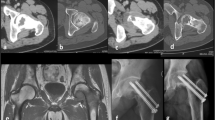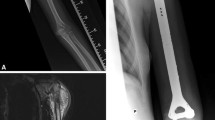Abstract
Background
The functional consequences of resecting the femoral nerve in conjunction with soft tissue sarcoma management are not well described. In comparison, sciatic nerve involvement by sarcoma was once considered an indication for amputation, but sciatic resection is now commonly performed as part of a limb-salvage approach. We compared functional outcomes following resection of either the femoral or sciatic nerve in patients with soft tissue sarcoma. We also compared both groups with patients with large thigh sarcomas without nerve involvement.
Methods
The prospectively collected database from a tertiary referral center for sarcomas was retrospectively reviewed to identify all patients with resection of the femoral nerve performed during wide excision of a soft tissue sarcoma. Patient demographics, treatment, complications, and functional outcomes in the form of the Musculoskeletal Tumor Society (MSTS) 1987 score, MSTS 1993 score, and Toronto Extremity Salvage Score (TESS) were collected. Control groups of sarcoma patients with sciatic nerve resection in the thigh as well as similarly sized tumors in the quadriceps requiring no nerve resections were also analyzed.
Results
Ten patients with femoral nerve resections were identified, all women, aged 47–78 years, with large soft tissue sarcomas of varied subtypes. All patients received adjuvant radiotherapy, most preoperatively. Six patients developed fractures during long-term follow-up, four in nonirradiated portions of the skeleton but directly from falls related to absent active knee extensors, and two at least partially attributable to sequelae of radiation. MSTS 1987 hip scores demonstrated one excellent, four good, and five fair results. MSTS 1993 hip scores averaged 71.4 ± 17.2% and TESS averaged 61.7 ± 21.8. There were no significant differences between the functional scores for patients with femoral or sciatic nerve resections (P = 1.0).
Conclusions
Femoral nerve resection appears more morbid than anticipated. The falls to which patients were prone, even years after surgery, subject them to ongoing long-term risks for fractures and other injuries. These nerve-specific functional implications should be considered when counseling patients in preparation for possible resection of the femoral nerve when it is directly involved by a soft tissue sarcoma.

Similar content being viewed by others
References
Simon MA, Spanier SS, Enneking WF. Management of adult soft-tissue sarcomas of the extremities. Surg Ann. 1979;11:363–402.
Gerrand CH, Wunder JS, Kandel RA, et al. Classification of positive margins after resection of soft-tissue sarcoma of the limb predicts the risk of local recurrence. J Bone Joint Surg Br. 2001;83(8):1149–55.
Clarkson PW, Griffin AM, Catton CN, et al. Epineural dissection is a safe technique that facilitates limb salvage surgery. Clin Orthop Relat Res. 2005;438:92–6.
Ghert MA, Abudu A, Driver N, et al. The indications for and the prognostic significance of amputation as the primary surgical procedure for localized soft tissue sarcoma of the extremity. Ann Surg Oncol. 2005;12(1):10–7.
Davis AM, Bell RS, Badley EM, et al. Evaluating functional outcome in patients with lower extremity sarcoma. Clin Orthop Relat Res. 1999;358:90–100.
Davis AM, Sennik S, Griffin AM, et al. Predictors of functional outcomes following limb salvage surgery for lower-extremity soft tissue sarcoma. J Surg Oncol. 2000;73(4):206–11.
Nambisan RN, Rao U, Moore R, Karakousis CP. Malignant soft tissue tumors of nerve sheath origin. J Surg Oncol. 1984;25(4):268–72.
Young JN, Friedman AH, Harrelson JM, et al. Hemangiopericytoma of the sciatic nerve. Case report. J Neurosurg. 1991;74(3):512–5.
O’Connor MI. Surgical management of malignant soft-tissue tumors. In Simon MA, Springfield D, editors. Surgery for bone and soft-tissue tumors. Philadelphia: Lipincott-Raven; 1998. p. 555–565.
Fuchs B, Davis AM, Wunder JS, et al. Sciatic nerve resection in the thigh: a functional evaluation. Clin Orthop Relat Res. 2001;382:34–41.
Bickels J, Wittig JC, Kollender Y, et al. Sciatic nerve resection: is that truly an indication for amputation? Clin Orthop Relat Res. 2002;399:201–4.
Brooks AD, Gold JS, Graham D, et al. Resection of the sciatic, peroneal, or tibial nerves: assessment of functional status. Ann Surg Oncol. 2002;9(1):41–7.
Enneking WF. Modification of the system for functional evaluation in the surgical management of musculoskeletal tumours. In: Enneking WF, editor. LImb salvage in musculoskeletal oncology. New York: Churchill Livingston; 1987. p. 626–39.
Enneking WF, Dunham W, Gebhardt MC, et al. A system for the functional evaluation of reconstructive procedures after surgical treatment of tumors of the musculoskeletal system. Clin Orthop Relat Res. 1993; 286:241–6.
Davis AM, Wright JG, Williams JI, et al. Development of a measure of physical function for patients with bone and soft tissue sarcoma. Qual Life Res. 1996;5(5):508–16.
Ghert MA, Davis AM, Griffin AM, et al. The surgical and functional outcome of limb-salvage surgery with vascular reconstruction for soft tissue sarcoma of the extremity. Ann Surg Oncol. 2005;12(12):1102–10.
Lee GW, Mackinnon SE, Brandt K, Bell RS. A technique for nerve reconstruction following resection of soft-tissue sarcoma. J Reconstr Microsurg. 1993;9(2):139–44.
Melendez M, Brandt K, Evans GR. Sciatic nerve reconstruction: limb preservation after sarcoma resection. Ann Plast Surg. 2001;46(4):375–81.
Stellini L. Interfascicular autologous grafts in the repair of peripheral nerves: eight years experience. Br J Plast Surg. 1982;35(4):478–82.
O’Sullivan B, Davis AM, Turcotte R, et al. Preoperative versus postoperative radiotherapy in soft-tissue sarcoma of the limbs: a randomised trial. Lancet. 2002;359(9325):2235–41.
Davis AM, O’Sullivan B, Bell RS, et al. Function and health status outcomes in a randomized trial comparing preoperative and postoperative radiotherapy in extremity soft tissue sarcoma. J Clin Oncol. 2002;20(22):4472–7.
Author information
Authors and Affiliations
Corresponding author
Rights and permissions
About this article
Cite this article
Jones, K.B., Ferguson, P.C., Deheshi, B. et al. Complete Femoral Nerve Resection with Soft Tissue Sarcoma: Functional Outcomes. Ann Surg Oncol 17, 401–406 (2010). https://doi.org/10.1245/s10434-009-0745-5
Received:
Published:
Issue Date:
DOI: https://doi.org/10.1245/s10434-009-0745-5




